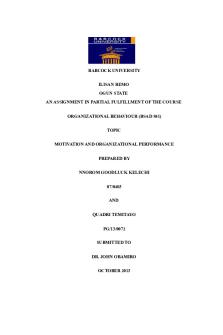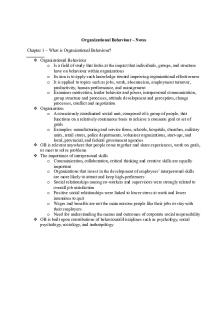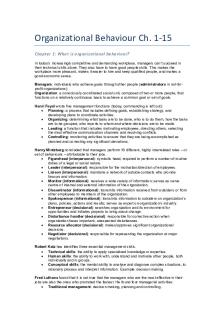Chapter 2 ORGANIZATIONAL BEHAVIOUR PDF

| Title | Chapter 2 ORGANIZATIONAL BEHAVIOUR |
|---|---|
| Author | Jemal Ali Salah |
| Course | Organizational behavior |
| Institution | Mekelle University |
| Pages | 23 |
| File Size | 302.1 KB |
| File Type | |
| Total Downloads | 71 |
| Total Views | 183 |
Summary
JEMAL ALI...
Description
CHAPTER 2: INDIVIDUAL BEHAVIOR IN ORGANIZATIONS
2.1.
PERSONALITY
When psychologists talk of personality, they mean a dynamic concept describing the growth and development of a person’s whole psychological system. Rather than looking at parts of the person, personality looks at some aggregate whole that is greater than the sum of the parts. Personality is a stable set of physical and psychological characteristics that makes each person unique. Personality is made up of a number of personality traits and is the product of interacting biological and environmental factors. It is the primary factor in individual differences. A close examination of the above definition indicates; first, personality is stable. It tends to stay the same over time and across situations. It is not completely rigid, however, as personality can evolve gradually over the long run. Second, personality consists of a set of characteristics rather than one or two traits. This set develops over time and makes the individual unique. Personality can be thought of as the sum total of ways in which an individual reacts to and interacts with others. It is most often described in terms of measurable traits that a person exhibits.
2.1.1. PERSONALITY DETERMINANTS
An early argument in personality research was whether an individual’s personality was the result of heredity or of environment. Was the personality predetermined at birth, or was it the result of the individual’s interaction with his or her environment? Clearly, there is no simple black-andwhite answer. Personality appears to be a result of both influences. In addition, today we recognize a third factor —the situation. Thus, an adult’s personality is now generally considered to be made up of both hereditary and environmental factors, moderated by situational conditions.
1. Heredity: refers to those factors that were determined at conception. The heredity approach argues that the ultimate explanation of an individual's personality is the molecular structure of the genes, located in the chromosomes. Evidence demonstrates that traits such as shyness, fear, and distress are most likely caused by inherited genetic
1
characteristics. If personality characteristics were completely dictated by heredity, they would be fixed at birth and no amount of experience could alter them. But personality characteristics are not completely dictated by heredity.
2. Environment : Among the factors that exert pressures on our personality formation are the culture in which we are raised, our early conditioning, the norms among our family, friends, and social groups, and other influences that we experience. The environment to which we are exposed plays a substantial role in shaping our personalities. Heredity sets the parameters or outer limits, but an individual's full potential will be determined by how well he or she adjusts to the demands & requirements of the environment.
3. Situation: A third factor, the situation, influences the effects of heredity and environment on personality. An individual's personality, although generally stable & consistent, does change in different situations. The varying demands of different situations call forth different aspects of one's personality. Furthermore, although certain generalizations can be made about personality, there are significant individual differences. The study of individual differences has come to receive greater emphasis in personality research.
2.1.2. PERSONALITY TRAITS
Personality traits are enduring (exhibited in a large number of situations) characteristics that describe an individual's behavior. The more consistent the characteristic and the more frequently it occurs in diverse situations, the more important that trait is in describing the individual. Psychologists have studied personality traits extensively, resulting in the identification of sixteen primary personality traits. These 16 traits have been found to be generally steady and constant sources of behavior, allowing prediction of an individual's behavior in specific situations by weighing the characteristics for their situational relevance. Unfortunately, the relevance of these traits for understanding behavior in organizations is far from clear. The 16 bi-polar personality traits are:
2
1. Reserved
Vs
2. Less intelligent
Outgoing Vs
More intelligent
3. Affected by feelings
Vs
emotionally stable
4. Submissive
Vs
Dominant
5. Serious
Vs
Happy-go-lucky
6. Expedient
Vs
Conscientious
7. Timid
Vs
Venturesome
8. Tough-minded
Vs
Sensitive
9. Trusting
Vs
Suspicious
10. Practical
Vs
Imaginative
11. Forthright
Vs
Shrewd
12. Self-assured
Vs
Apprehensive
13. Conservative
Vs
Experimenting
14. Group-dependent
Vs
Self-sufficient
15. Uncontrolled
Vs
Controlled
16. Relaxed
Vs
Tense
2.1.3. THE BIG FIVE PERSONALITY DIMENSIONS Over time psychologists and human resource management researchers have condensed countless personality traits into a list of five major personality dimensions, known as the Big Five. Researchers have found these five dimensions to be consistent components of personality. The Big Five factors are: 1. Extraversion/introversion This dimension captures one’s comfort level with relationships. Extraverts (high in extraversion) tend to be friendly and outgoing and to spend much of their time maintaining and enjoying a large number of relationships. Introverts tend to be reserved and to have fewer relationships, and they are more comfortable with solitude than most people are. 2. Agreeableness It describes a person’s general friendliness and courtesy as well as the degree to which she or he is trusting and liked by others. Agreeableness further includes flexibility and willingness to cooperate with others. Someone who is agreeable is sociable and friendly, generally easy to get long with, and willing to cooperate with
3
others. This dimension refers to an individual’s propensity to defer to others. High agreeable people value harmony more than they value having their say or their way. They are cooperative and trusting of others. People who score low on agreeableness are cold, antagonistic and focus more on their own needs than on the needs of others. 3. Conscientiousness This dimension refers to the number of goals on which a person focuses. It is defined as being hardworking, persevering, and achievement oriented. A high conscientious person pursues fewer goals, in a purposeful way, and tends to be responsible, persistent, dependable, and achievement-oriented. Those who score low on this dimension tend to be more easily distracted, pursuing many goals, disorganized, unreliable and more hedonistic. 4. Emotional stability This dimension taps a person's ability to withstand stress. People with positive emotional stability tend to be calm, self-confident, and secure. Those with highly negative scores tend to be nervous, anxious, depressed, and insecure. 5. Openness to experience The final dimension addresses one’s range of interests and fascination by novelty and innovation. They tend to be imaginative, curious, artistically sensitive, and intellectual. Those at the other end of the openness category appear more conventional and find comfort in the familiar.
Core Traits Extraversion Agreeableness Conscientiousness Emotional stability Openness to experience
Descriptive Characteristics of High Scores Sociable, Outgoing, Talkative, Assertive, Gregarious Cooperative, Warm, Caring, Good-Natured, Courteous, Trusting Dependable, Hardworking, Organized, Self-Disciplined, Persistent, Responsible Calm, Secure, Happy, Unworried Curious, Intellectual, Creative, Cultured, Artistically Sensitive, Flexible, Imaginative
IMPLICATION FOR MANAGEMENT Several of the big five dimensions of personality have links to work related behaviors, although none is a strong predictor of performance. Of the five dimensions, conscientiousness is the most strongly correlated to job performance. This makes sense: individuals who are dependable, organized, and hard- working tend to perform better in their jobs. Most managers agree that a
4
good employee is dependable, shows up on time, finishes work by deadlines, and is willing to work hard. Extroversion is the big five dimensions with the second highest correlation to job- related behaviors. Extroversion is particularly important in jobs that rely on social interaction, such as management or sales person. Unlike conscientiousness, which can apply to all jobs levels or occupations, extroversion is not an essential trait for all jobs and individuals can succeed without being extroverted. Openness to experience can help performance in some instances but not others. For example, being open to new experiences can help employees or managers perform well in new training because they would be motivated to explore new ideas and to learn. As one would expect, emotional stability relates to job behaviors and performance. At the extreme, individuals who are neurotic are not likely to be able to function in organizations. The most important managerial implication of the big five dimensions is that except for conscientiousness, no single trait is strongly linked to how well an employee will perform in all types and levels of jobs. Instead, managers need to consider many factors, especially the personjob fit.
2.1.4
KEY
PERSONALITY
ATTRIBUTES
INFLUENCING
ORGANIZATION
BEHAVIOR 1. Locus of Control Some people believe that they are masters of their own fate. Other people see themselves as pawns of fate, believing that what happens to them in their lives is due to luck or chance. The first type, those who believe that they control their destinies, have been labeled internals, whereas the latter, who see their lives as being controlled by outside forces, have been called externals. A person's perception of the source of his or her fate is termed locus of control. Individuals who have high scores in externality are less satisfied with their jobs, have higher absenteeism rates, are more alienated from the work setting, and are less involved on their jobs than are internals. 2. Machiavellianism An individual high in Machiavellianism is pragmatic, maintains emotional distance, and believes that ends can justify means. High Machs manipulate more, win more, are persuaded less, and persuade others more than do low Machs. Yet these high-Mach outcomes are moderated by situational factors. It has been found that
5
high Machs flourish (1) when they interact face-to-face with others rather than indirectly; (2) when the situation has a minimum number of rules and regulations, thus allowing latitude for improvisation; and (3) when emotional involvements with details irrelevant to winning distract low Machs. 3. The Self-Concept People's attempts to understand themselves are called the self-concept in personality theory. The self is a unique product of many interacting parts and may be thought of as the personality viewed from within. This self is particularly relevant to the concepts of self-esteem and self-efficacy in the field of organizational behavior. 4. Self-Esteem is directly related to expectations for success. People's self-esteem has to do with their self-perceived competence and self-image. The most recent studies indicate that self-esteem plays at least an important moderating role in areas such as emotional and behavioral responses and stress of organizational members. Employees with high self-esteem feel unique, competent, secure, empowered, and connected to the people around them. High SEs believe that they possess the ability they need to succeed at work. Individuals with high self-esteem will take more risks in job selection and are more likely to choose unconventional jobs than people with low self-esteem. Low SEs are more susceptible to external influence than are high SEs. Low SEs depend on the receipt of positive evaluations from others. As a result, they are more likely to seek approval from others and more prone to conform to the beliefs and behaviors of those they respect than are high SEs. In managerial positions, low SEs will tend to be concerned with pleasing others and, therefore, are less likely to take unpopular stands than are high SEs. A number of studies confirm that high SEs are more satisfied with their jobs than are low SEs. 5. Self-Efficacy Self-efficacy is concern with self-perceptions of how well a person can cope with situations as they arise. Those with high self-efficacy feel capable and confident of performing well in a situation. Self-efficacy is conceptually close to self-esteem. Selfesteem tends to be a generalized trait (it will be present in any situation) while selfefficacy tends to be situation-specific. Self-efficacy is derived from four sources: (1) performance accomplishments, (2) modeled exposure, (3) verbal persuasion, and physiological arousal. A recent meta-analysis by Research outputs found a highly significant relationship between self-efficacy and performance in organizational settings. There is considerable evidence that employees who have higher self-efficacy are higher
6
performers than those who have lower self-efficacy; that this efficacy-performance relationship is cyclic in nature-performance affects self-efficacy, which in turn affects performance, and so on; that training employees can lead to their enhanced self-efficacy. 6. Self-Monitoring It refers to an individual's ability to adjust his or her behavior to external, situational factors. Individuals high in self-monitoring show considerable adaptability in adjusting their behavior to external situational factors. They are highly sensitive to external cues/signal and can behave differently in different situations. High self-monitors are capable of presenting striking contradictions between their public persona and their private self. Low self-monitors can't disguise themselves in that way. They tend to display their true dispositions/character and attitudes in every situation; hence, there is high behavioral consistency between who they are and what they do. Evidence suggests that high self-monitors tend to pay closer attention to the behavior of others and are more capable of conforming than are low self-monitors. In addition, high self-monitoring managers tend to be more mobile in their careers and receive more promotions (both internal & cross-organizational). It may also be hypothesize that high self-monitors will be more successful in managerial positions in which individuals are required to play multiple, and even contradicting, roles. The high self-monitor is capable of putting on different "faces" for different audiences. 7. Risk Taking People differ in their willingness to take chances. This propensity to assume or avoid risk has been shown to have an impact on how long it takes managers to make a decision and how much information they require before making their choice. It makes sense to recognize the individual differences on this dimension and even to consider aligning risk-taking propensity with specific job demands. For instance, a high risktaking propensity may lead to more effective performance for a stock trader in a brokerage firm because that type of job demands rapid decision-making. On the other hand, a willingness to take risks might prove a major obstacle to an accountant who performs auditing activities. The latter job might be better filled by someone with a low risk-taking propensity.
7
Type A Personality. Type A personality is "aggressively involved in a chronic, incessant struggle to achieve more and more in less and less time, and, if required to do so, against the opposing efforts of other things or other persons." Type A's: 1. are always moving, walking, and eating rapidly; 2. feel impatient with the rate at which most events take place; 3. strive to think or do two or more things at once; 4. cannot cope with leisure time; 5. are obsessed with numbers, measuring their success in terms of how many or how much of everything they acquire. In contrast to the Type A personality is the Type B, who is exactly the opposite. Type B's are "rarely harried by the desire to obtain a wildly increasing number of things or participate in an endless growing series of events in an ever-decreasing amount of time." Type B's: 1. never suffer from a sense of time urgency with its accompanying impatience; 2. feel no need to display or discuss either their achievements or accomplishments unless such exposure is demanded by the situation; 3. play for fun and relaxation rather than to exhibit their superiority at any cost; 4. can relax without guilt. Type A's operate under moderate to high levels of stress. They subject themselves to more or less continuous time pressure, creating for themselves a life of deadlines. These characteristics result in some rather specific behavioral outcomes. For example, Type A's are fast workers because they emphasize quantity over quality. In managerial positions, Type A's demonstrate their competitiveness by working long hours and, not infrequently, making poor decisions because they make them too fast. Type A's are also rarely creative. Because of their concern with quantity and speed, they rely on past experiences when faced with problems. They will not allocate the time that is necessary to develop unique solutions to new problems. They rarely vary in their responses to specific challenges hence, their behavior is easier to predict than that of Type B's. Despite the Type A's hard work, the Type B's are the ones who appear to make it to the top. Great salespersons are usually Type A's; senior executives are usually Type B's. The answer lies in the tendency of Type A's to trade off quality of effort for quantity. Promotions in corporate and
8
professional organizations usually go to those who are wise rather than to those who are merely hasty, to those who are tactful rather than to those who are hostile, and to those who are creative rather than those who are merely agile in competitive strife.
2.2.
PERCEPTION
Perception is the process of receiving, selecting, organising, interpreting, checking, and reacting to sensory stimuli or data. It is a process through which we receive, filter, organize, interpret and attach meaning to information taken from the environment. It is the way we view the world around us or becoming aware of something via the senses. Perception represents the psychological process whereby people take information from the environment and make sense of their world. It includes an awareness of the world – events, people, objects, situations, and so on – and involves searching for, obtaining, and processing information about the world. It adds meaning to information gathered via the five senses of touch, smell, hearing, vision, and taste. Perception is the primary vehicle through which we come to understand our surroundings and ourselves. Perception is thus a mental & cognitive process that enables us to interpret & understand our surroundings. Recognition of objects is one of this process’s major functions. People must recognize objects to meaningfully interact with the environment. Because each person gives his or her meaning to stimuli, different individuals see the same thing in different ways. The cognitive map of the individual is not, then, a photographic representation of the physical world: it is, rather, a partial,...
Similar Free PDFs

Chapter 2 ORGANIZATIONAL BEHAVIOUR
- 23 Pages
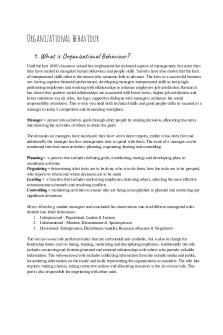
Organizational behaviour
- 67 Pages

Organizational Behaviour
- 2 Pages
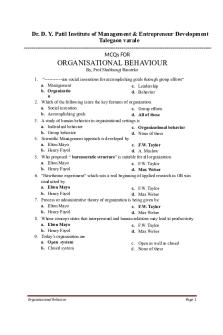
Organizational Behaviour mcqs
- 27 Pages
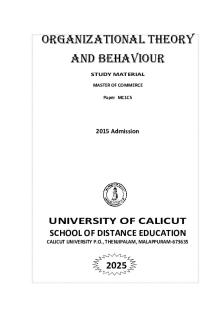
Organizational theory and behaviour
- 186 Pages
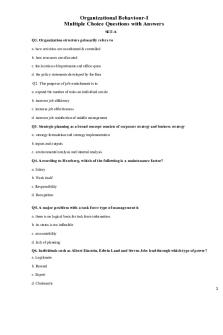
Organizational Behaviour MCQ SET
- 20 Pages
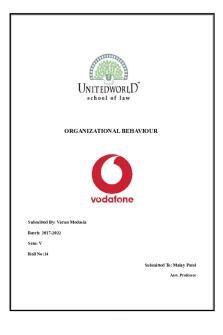
Organizational Behaviour Project
- 15 Pages

Organizational Behaviour Glossary
- 17 Pages
Popular Institutions
- Tinajero National High School - Annex
- Politeknik Caltex Riau
- Yokohama City University
- SGT University
- University of Al-Qadisiyah
- Divine Word College of Vigan
- Techniek College Rotterdam
- Universidade de Santiago
- Universiti Teknologi MARA Cawangan Johor Kampus Pasir Gudang
- Poltekkes Kemenkes Yogyakarta
- Baguio City National High School
- Colegio san marcos
- preparatoria uno
- Centro de Bachillerato Tecnológico Industrial y de Servicios No. 107
- Dalian Maritime University
- Quang Trung Secondary School
- Colegio Tecnológico en Informática
- Corporación Regional de Educación Superior
- Grupo CEDVA
- Dar Al Uloom University
- Centro de Estudios Preuniversitarios de la Universidad Nacional de Ingeniería
- 上智大学
- Aakash International School, Nuna Majara
- San Felipe Neri Catholic School
- Kang Chiao International School - New Taipei City
- Misamis Occidental National High School
- Institución Educativa Escuela Normal Juan Ladrilleros
- Kolehiyo ng Pantukan
- Batanes State College
- Instituto Continental
- Sekolah Menengah Kejuruan Kesehatan Kaltara (Tarakan)
- Colegio de La Inmaculada Concepcion - Cebu


